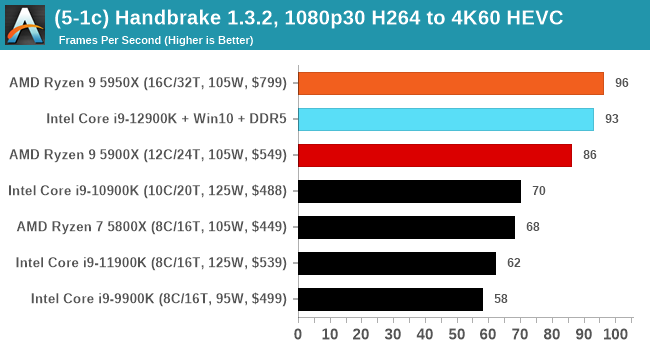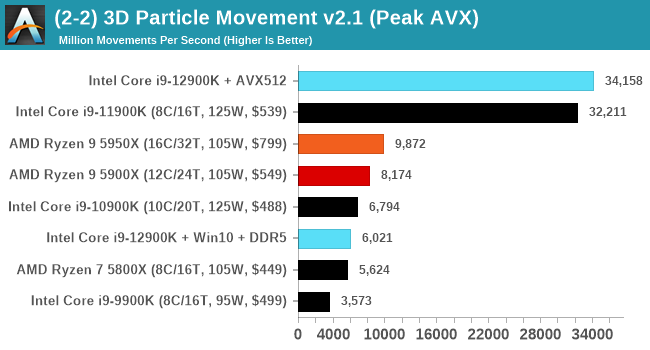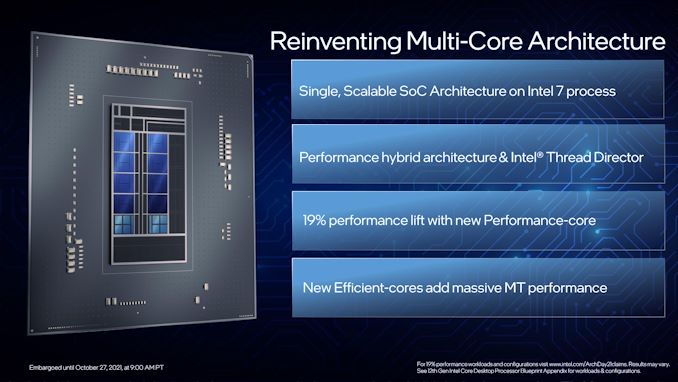The Intel 12th Gen Core i9-12900K Review: Hybrid Performance Brings Hybrid Complexity
by Dr. Ian Cutress & Andrei Frumusanu on November 4, 2021 9:00 AM ESTConclusion: Variables Maketh the CPU
Suffice to say, Intel’s new 12th Generation Core family has added more variables to the mix than a traditional processor launch. The combination of different types of core, coming at a time where a new operating system has just been launched, but also at the inflection point of a new type of memory. Let’s break down some of the differences we’ve observed in our testing.
When we compare Windows 10 to Windows 11, purely on throughput benchmarks, we don’t find much difference. There are a few spots where Windows 11 has a slight advantage in multi-threaded workloads, but this comes down to how new threads are spawned between the performance cores and the efficiency cores. Intel stated that the performance between the two, at least for CPU workloads, should be within a few percentage points, stating that Windows 11 should have lower run-to-run variance. We can corroborate this in our testing. Windows 10 also had some scheduling issues with low priority threads, which we expect to be ironed out with updates.
Comparing the new DDR5 to the old DDR4 is a different story, as the new memory standard offers a substantial uplift when it comes to memory bandwidth. As we saw recently with the M1 Max review, sometimes memory bandwidth can be a limiting factor. In our testing, DDR5 had a minor lead in single threaded tests but in a lot of multithreaded tests, the lead was significant. For real world, we had examples of +14% in Agisoft, +10% in NAMD, +8% in V-Ray, +10% in Handbrake, and +20% in WinRAR. In SPEC2017, we saw a couple of single threaded workloads get +15% improvements over DDR5, but in multi-threaded this was up to +40% on average, or more than 40% in specific tests. This also comes down to the doubled memory channels (4x32-bit vs 2x64-bit) which can be better utilized on top of the bandwidth increases.
Now comparing the P-core to the E-core, and it’s a story of how the E-core individually can perform on par with a Skylake core. Having eight extra Skylake-class cores is nothing to be sniffed at. In a lot of tests the E-core is half the performance of the P-core, but the P-core is itself is now the market leader in performance. The Golden Cove core inside Alder Lake has reclaimed the single-threaded performance crown with an uplift in SPEC of 18-20%, which is in line with Intel’s 19% claim. This puts it ahead of Apple’s M1 Max or 6% (int) and 16% (fp) ahead of AMD’s Zen 3 core.
The Core i9-12900K
Combining fast P-cores, Skylake-class E-cores, and DDR5 into one package means that Intel has certainly jumped from behind the competition to in front of it, or at least in the mix. When you have your operating system set up just right, and no issues with schedulers, it outperforms AMD’s offering when single core performance matters, and in multi-threaded workloads, it does tend to sit somewhere between a 5900X and a 5950X.

It’s important to note that in some tests, the Core i9-12900K does win outright. It’s at this point we should consider how much is core related vs standards related: DDR5 has produced somewhat of an uplift, and the competition is expected to claw some of that back when they introduce it, but those products are expected more towards the latter half of 2022. For users with those specific workloads today, and willing to pay the DDR5 early adopter tax, Alder Lake can provide performance uplifts right now.

Power is an interesting topic, and although our peak power numbers when all cores were loaded were above the 241W Turbo power on the box, in real world workloads it didn’t tend to go that high. The P-cores alone on the chip matched the power consumption of Intel’s 11th Generation in AVX2 workloads, but adding in the E-cores does put it over the previous generation. I’m not entirely sure what that says about Intel’s 7 manufacturing process compared to the 10SF used before. A lot of the performance gains here appear to come from IPC and DDR5, and that doesn’t seem to have come with performance per watt gains on the P-cores. It means that Intel is still losing on power efficiency at load compared to the competition.

I have to say a side word about AVX-512 support, because we found it. If you’re prepared to disable the E-cores, and use specific motherboards, it works. After Intel spent time saying it was fused off, we dug into the story and found it still works for those that need it. It’s going to be interesting to hear how this feature will be discussed by Intel in future.
Overall though, it’s no denying that Intel is now in the thick of it, or if I were to argue, the market leader. The nuances of the hybrid architecture are still nascent, so it will take time to discover where benefits will come, especially when we get to the laptop variants of Alder Lake. At a retail price of around $650, the Core i9-12900K ends up being competitive between the two Ryzen 9 processors, each with their good points. The only serious downside for Intel though is cost of switching to DDR5, and users learning Windows 11. That’s not necessarily on Intel, but it’s a few more hoops than we regularly jump through.











474 Comments
View All Comments
Netmsm - Sunday, November 7, 2021 - link
I believe, we're not talking about ISO-efficiency or manufacturing or engineering details as facts! These are facts but in the appropriate discussion. Here, we have results. These results are produced by all those technological efforts. In fact, those theoretical improvements are getting concluded in these pragmatical information. Therefore, we should NOT wink at performance per watt in RESULTS - not ISO-related matters.So, the fact, my friend, is Intel new architecture does tend to suck 70-80 percent more power and give 50-60 percent more heat. Just by overclocking 100MHz 12900k jumps from ~80-85 to 100 degrees centigrade while consuming ~300 watts.
Once in past, AMD tried to get ahead of Nvidia by 6990 in performance because they coveted the most powerful graphic card title. AMD made the hottest and the noisiest graphic card in the history and now Intel is mimicking :))
One can argue that it is natural when you cannot stop or catch a rival so try to do some chicaneries. As it is very clear that Anandtech deliberately does not tend to put even the nominal TDP of Intel 12900k in their benches. I loathe this iniquitous practice!
Wrs - Sunday, November 7, 2021 - link
@Netmsm I believe the mistake is construing performance-per-watt (PPW) of a consumer chip as indicative of PPW for a future server chip based on the same core. Consumer chips are typically optimized for performance-per-area (PPA) because consumers want snappiness and they are afraid of high purchase costs while simultaneously caring much less than datacenters about cost of electricity.Netmsm - Monday, November 8, 2021 - link
@Wrs You cannot totally separate efficiency of consumer and enterprise chips!As an incontrovertible fact, architecture is what primarily (not completely) determines the efficacy of a processor.
Is Intel going to kit out upcoming server CPUs in an improved architecture?
Wrs - Monday, November 8, 2021 - link
@Netmsm Architecture, process, and configuration all can heavily impact efficiency/PPW. I’m not aware of any architectural reason that Golden Cove would be much less efficient. It’s a mildly larger core, but it doesn’t have outrageous pipelining or execution imbalances. It derives from a lineage of reasonably efficient cores, and they had to be as they remained on aging 14nm. Processwise Intel 7 isn’t much less efficient than TSMC N7, either. (It could even be more efficient, but analysis hasn’t been precise enough to tell.) But clearly ADL in a 12900/12700k is set up to be inefficient yet performant at high load by virtue of high frequency/voltage scaling and thermal density. I could do almost the same on a dual CCD Ryzen, before running into AM4 socket limits. That’s obviously not how either company approaches server chips.Netmsm - Tuesday, November 9, 2021 - link
When you cannot infer or appraise or guess we should drop it for now and wait for real tests of upcoming server chips to come.regards ^_^
GamingRiggz - Tuesday, March 15, 2022 - link
Thankfully you are no engineer.AbRASiON - Thursday, November 4, 2021 - link
AMD would have less of an issue If the 5000 processors weren’t originally priced gouged.Many people held off switching teams due to that. Instead of the processor being an amazing must buy, it was just a decent purchase. So they waited.
If you’re On the back foot in this game, you should be competing hard always to get that stranglehold and mind share.
I’m glad they’re competing though and hopefully they release some very competitive and REASONABLY PRICED products in the near future.
Fataliity - Thursday, November 4, 2021 - link
Their revenue and marketshare #'s beg to disagree.Spunjji - Friday, November 5, 2021 - link
They've been selling every CPU they can make. There are shortages of every Zen 3 based notebook out there (to the extent that some OEMs have cancelled certain models) and they're selling so many products based on the desktop chiplets that Threadripper 5000 simply isn't a thing. You ought to factor that into your assessment of how they're doing.BillBear - Thursday, November 4, 2021 - link
Is anyone gullible enough to forget more than a decade of price gouging, low core counts and nearly nonexistent performance increases we got from Intel, vs. the high core counts, increasing performance, and lower prices we got from AMD?